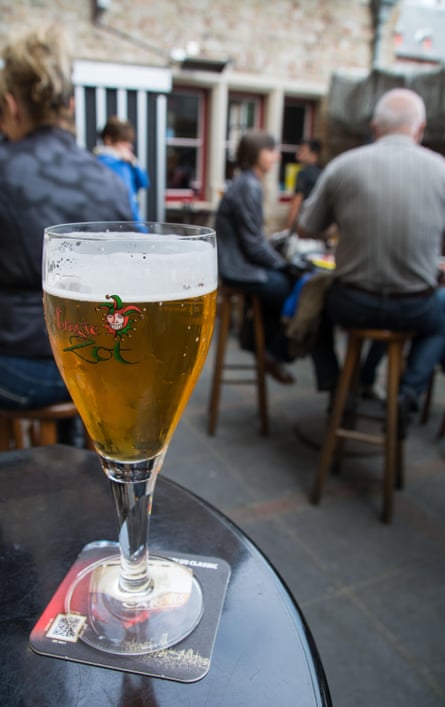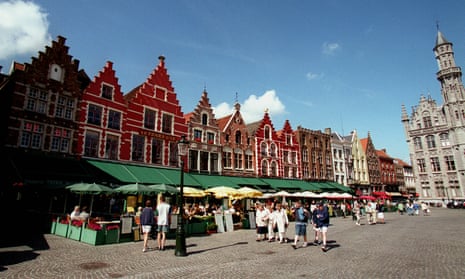It had long been the stuff of bar-stool fantasies: a beer pipeline that could funnel the staple drink of Belgium beneath the cobbled streets and gothic houses of Bruges.
“Everyone always thought, ‘it’s a dream, it’s a joke, it is something that is not realisable at all,’” said Xavier Vanneste, director and heir to De Halve Maan, Bruges’s only continuously working old brewery.
Now, though, the dream is about to become reality: Belgium’s first major beer pipeline will start pumping beneath Bruges from September.
If all goes to plan, enough beer to fill 12,000 bottles an hour will slosh down the two-mile underground pipeline from De Halve Maan (Half Moon) in the city centre to an out-of-town bottling plant.
Vanneste was inspired when he saw workmen laying broadband cables outside his house and, on the spur of the moment, dashed into the street. “When I started talking to those guys,” he said, “I realised it was possible, it was feasible.”
Laying broadband or gas is one thing; a beer pipeline is something else. No private company had ever been allowed to lay cable under the city’s cobbled lanes and around the renowned medieval buildings that have secured Bruges’s place on the Unesco world heritage list. And at first, city officials were dubious.
“My first reaction was, ‘Oh my God, what are they thinking?’” said the mayor of Bruges, Renaat Landuyt. But it did not take long to win him round, he said, when he realised the pipeline would sharply reduce the number of beer tankers driving in and out of the city.

He sees the pipeline as a way to preserve a working brewery in the historic centre and prevent Bruges from turning into a museum. “If we don’t make sure that people can work in the city centre, we will kill the city centre,” he said.
Brewing on the De Halve Maan site was first recorded in 1564. Vanneste’s ancestor took over the brewery in 1856, where he made “a hazy beer that tastes a little sour”.
Before the second world war, Bruges city centre was home to at least 30 working breweries. At that time beer supplies were delivered by horse and cart to people’s homes and tourists had not yet discovered the city’s Flemish old masters and winding canals. De Halve Maan is the last survivor of that vanished world, although one venerable old brewer recently reopened after a gap of 60 years.
Today, beer is no longer brewed in two-metre deep open vats that have to be scrubbed out with hand cloths and brooms. Instead water, barley, yeast and hops are mixed in four state-of-the-art steel kettles, overlooked by St Arnold, the patron saint of brewing. Several floors up, visitors can stand under the red-brick brewery chimney, with the city’s rooftops spread at their feet and the air rich with the tea-like, malty aroma of brewing beer.
Some financial experts advised Vanneste to close the city brewery – a charming warren of rooms dating back to the 16th century – and move operations to the bland industrial estate housing the bottling plant. But that would have meant De Halve Maan could no longer say its beer was made in Bruges. “For me, Unesco heritage is not only about bricks and material things, but having a living brewery here,” Vanneste says. “That is a part of the immaterial heritage.”
“Bruges is full of tourist traps,” he continues. “You have chocolate that is not made here or even in Belgium. We want to brew every single litre here ... right where it has been brewed for so many centuries, just as Trappist beer is brewed in the abbey or champagne is brewed in the Champagne area.”
So he hired tunnelling experts from the oil and gas industry and Belgium’s top professor in malting and brewing. Laying the pipeline was done using computer-guided drills to minimise street digging. That pleased city planners, but increased costs.

Despite initial doubts from city councillors, the beer pipeline has become an urban hit, sparking endless jokes about illegal tapping points and secret home drilling. Some €300,000 of the €4m (£3.4m) budget was raised through crowdfunding. The most expensive gold membership costs €7,500 and allows the buyer a bottle of blonde Brugse Zot (the Bruges Fool) beer every day for life and 18 personalised glasses.
Local business owners, who have long seen beer tankers struggling to turn around on narrow lanes, are supportive.
Gavin Vandenbroucke is manager of the New Walnut, a family-run brasserie, decked out in bunting coloured the red, black and gold of the national flag to celebrate that other source of Belgian pride, the football team. He describes the beer pipeline as very special.
“It is big publicity for Bruges, for the brewery and for Belgian beers,” he said. The opening will be welcome, as his takings are sharply down since the Paris attacks and then the bombings in Brussels put Belgium on high alert.
Over the street, Marc Souris who owns the Fascino hat shop, was sceptical that traffic would decrease, pointing out that the ingredients for making beer still had to be delivered to the brewery. But the project was a “great and unique” one that was bound to bring more tourists to the city. Around 100,000 people visit the brewery each year. “We get a little slice of that cake,” he said.
His turnover, too, is down – by a third on last year. “March was a disaster because of the Brussels attacks … [and] June is too quiet,” he said. A series of strikes on Belgian railways last month did not help, either. “It should be packed now.”
Nicole Stael, who sells postcards, snow globes and souvenir plates, said that in the 40 years she had owned her gift shop business had not been so bad. Fear of the unknown was keeping people away, she thought. “[The threat] is not in one place and people are no longer sure where is safe,” she said.
Across the square, outside the brewery, horses and carriages clip clop down the lane. De Halve Maan is in the final weeks of testing the beer pipeline: four separate polyethylene tubes that look like ordinary drainpipes.
The brewer does not think the pipeline will pay back in less than 20 years, but it appears to be a shrewd commercial move. De Halve Maan has seen double-digit growth for its beers for more than a decade and now exports to 30 countries, including the US and China.
The Bruges brewer is riding a wave of interest in traditional Belgian beers, as drinkers turn against bland, watery lagers and look for flavour. Although Belgians are drinking less beer than they used to, they are getting choosier. Beer drinkers are opting for Trappist and abbey brews, ales and blonde beers, rather than mid-priced lagers, according to the latest market research by Euromonitor.
People are also rediscovering family brewers, partly driven by the craze for craft beers. “A lot of people love craft beers, they are very hoppy and very strong, but they are a little bit too much in flavour at the moment,” said Marc Stroobandt, a master beer sommelier. “The family breweries have been doing it for years and have found the right balance of flavour and drinkability.”
He thinks the pipeline will help De Halve Maan preserve its authenticity and provenance, adding: “I am so surprised they got authorisation to do it.”

Comments (…)
Sign in or create your Guardian account to join the discussion